b0fe2636bc3076811bccc2eb774ce226.ppt
- Количество слайдов: 80

ИОННЫЕ ИСТОЧНИКИ Проблемы, Достижения, Перспективы. В. Г. Дудников

Физика пучков заряженных частиц и ускорительная техника • • American Physical Society-APS, Beam Division. (APS. org) Budker Institute of Nuclear Physics (BINP), (inp. nsk. su) G. I. Budker (1918 -1977), Электрон-позитронные встречные пучки 1965, Протон- антипротонные встречные пучки Частота столкновений- светимость Нужна высокая плотность пучков в месте встречи: высокая яркость пучков

G. I. Budker (1918 -1977)

Получение пучков с высокой яркостью • Для получения пучков с высокой яркостью были разработаны: • Перезарядная инжекция протонов в циклические ускорители (Charge-exchange (stripping) injection, BDD, Budker, Dimov, Dudnikov, 1965) • Электронное охлаждение ( Electron cooling, Budker, Skrinsky, Dikansky, Parkhomchuk, . . . ) • Поверхностно-плазменные источники отрицательных ионов (Surface-Plasma Sources (SPS), BDD, Belchenko, Dimov, Dudnikov) с высокой яркостью пучков. • Стохастическое охлаждение (Stochastic cooling, CERN, NP, W, Z)

Hadron Colliders • • Proton Antiproton Collider 2 x 1 Te. V, Tevatron, Perimeter L=6 km, FNAL. gov Head of Tevatron Department- Vladimir Shiltsev, F. F. NGU accelerators Proton Collider LHC- CERN. sh CERNcurer Friendsofthensu. org

Vladimir Balakin (1968)- director of BINP division & Vladimi Shiltsev (1990), Head of TEVATRON Department

40 лет Ф. Ф. НГУ в Chicago, FNAL & ANL

ION SOURCES • Ионный источник- Ion Source- Устройство для создания ионных пучков – пространственно сформированных упорядоченных потоков ионов, со скоростями много большими тепловых. • Ионы: заряженные частицы, взаимодействуют с полями, гибкое управление. • Положительные Н+ = Н-е, потенциал ионизации I~10 e. V, … • Отрицательные Н- = Н+ е, электронное сродство А~1 e. V • Ионизация: электронным ударом, поверхностная, … • Прилипание электронов: радиационное, диссоциативное, на поверхности, …

Применения ИИ: • • * * * Ускорители, Ионная имплантация, Масс-спектрометрия, Разделение изотопов, Инжекторы в УТС, Ионное распыление, напыление пленок, ионное травление, микро-нано обработка( micro/nano fabrication), Плазменные технологии ( Проф. Ю. И. Бельченко ), “ Подвал “ Конференции: International Conference Ion Sources (ICIS 2003), … Electron, photon, ion beam, JVSTech. Google. com, yahoo. com Ion Sources, Ion implantation, ICIS 2003, ….

История • E. Goldstein 1886, Первое наблюдение ионного пучка, Каналловые лучи, • Обнаружение изотопов, Астон. • Электромагнитное разделение изотопов, Lawrenc, • Ионная имплантация в полупроводники, • Ускорители, Перезарядная инжекция, ППИ(SPS), • УТС, • Микро-нано технологии.

Параметры ионных пучков, ПРОБЛЕМЫ • • • Энергия ионов W=e. U. Заряд: е. Z Интенсивность- ток ионного пучка I, р. А- к. А, Плотность тока J=I/S. Разброс энергий поперечного движения(поперечная температура Тt ~1 e. V) Эмиттанс ( поперечный фазовый объем) ε= r vt. Яркость пучка: интенсивность/ (эмиттанс)2 I/ε 2 ~ J/Tt. Energy spread ΔW/W Perveance P= I/U 3/2. Lifetime Cost for Ownership

Emittance, Brightness, Ion Temperature δ Emission slit y l Δx Emittance Δα Normalized emittance Normalized brightness Half spreads of energy of the transverse motion of ions Reduced to the plasma emission slit Characteristics of quality of the beam formation: x

Классификация ионных источников • • • Плазменные: образование ионов в плазме А+е= А+ +2 е С газовым разрядом постоянного тока, ВЧ, СВЧ, … Однозарядных, Многозарядных ионов, Отрицательных С поверхностной ионизацией: положительной, отрицательной, с полевой эмиссией, … Поверхностно-плазменные (Surface-Plasma Sources) (SPS) Перезарядные, Лазерные Электроннопучковые (EBIS) Стационарные(DC, CW), Импульсные. Polarized ions.

Системы формирования ионных пучков • Формирование ионных пучков- ускорение и фокусировка электрическим полем между эмиттером и экстрактором. • Самосогласованная граница плазмы. • Моделирование (Computer simulation). • Пространственный заряд, дефокусировка. • Транспортировка интенсивных пучков, фокусирующие системы. • Компенсация пространственного заряда.

RF Ion Source

Разделение изотопов

Budker Institute of Nuclear Physics

Arc- discharge- based ion source

DNBI arrangement at TCV

Intensity of Negative Ion Beams: 1971 -discovery of Cesium Catalysis.

Contents • • • Introduction. Historical remarks. Change-Exchange injection. Negative ion production in surface- plasma interaction. Cesium catalysis. Surface Plasma Sources- SPS. Discharge stability noiseless operation. Charge-exchange cooling. Electron suppression. Beam extraction, formation, transportation. Space charge neutralization. Instability damping. SPS design. Gas pulser, cesium control, cooling. SPS life time. SPS in accelerators. Further development. Summary. Acknowledgment.

History of Surface Plasma Sources Development (J. Peters, RSI, v. 71, 2000)

First version of Planotron (Magnetron) SPS, INP, 1971, Beam current up to 300 m. A, 1 x 10 mm 2

Schematic Diagrams of Surface Plasma Sources with Cesium Catalysis of Negative Ion formation (a) planotron (magnetron) flat cathode (b) planotron geometrical focusing (cylindrical and spherical) (c) Penning discharge SPS (Dudnikov type SPS) (d) semiplanotron (e) hollow cathode discharge SPS with independent emitter (f) large volume SPS with filament discharge and based emitter (g) large volume SPS with anode negative ion production (h) large volume SPS with RF plasma production and emitter 1 - anode 2 - cold cathode emitter 3 - extractor with magnetic system 4 - ion beam 5 - biased emitter 6 - hollow cathode 7 - filaments 8 - multicusp magnetic wall 9 - RF coil 10 - magnetic filter

Large Volume Surface-Plasma Sources

Neutral Beam Injector for Tokamak, 40 A, 0. 5 Me. V

22. 1 Development of a Large Volume Negative Ion Source for ITER Neutral Beam Injector • Y. Okumura, T. Amemiya, T. Iga, M. Kashiwagi, T. Morishita, M. Hanada, T. Takayanagi, K. Watanabe, Japan Atomic Energy Research Institute, Japan • Design of the large negative ion source for the neutral beam injector in International Thermonuclear Experimental Reactor (ITER) has been completed. The ion source is required to produce hydrogen/deuterium negative ion beam of 40 MW(40 A, 1 Me. V) for pulse duration of more than 1000 s. The ion source is a cesium-seeded volume source, consisting of a multi-cusp plasma generator and a five-stage electrostatic accelerator. Negative ions are extracted and accelerated in multi-aperture grids, where 1300 apertures of 14 mm in diameter is distributed over the area of 60 cm x 160 cm. Multiple beamlets extracted from the grids should be focused precisely toward a focal point to achieve a high geometrical efficiency of the neutral beam injector. Beam optics in the multi-stage electrostatic accelerator has been studied in JAERI 400 ke. V H- ion source. It was demonstrated that convergent beamlets having a divergence of 3 mrad are produced and focused within an accuracy of several mrad. Beamlet-beamlet interaction is observed and the experimental result agrees well with the 3 D ion trajectory simulation. Negative ion beam acceleration in a 1 Me. V prototype accelerator is in progress using a new vacuum insulated accelerator column. Latest status of the R&D for ITER ion source is presented.

H- Detachment by Collisions with Various Particles and Resonance Charge-Exchange Cooling Resonance charge -exchange cooling

Discharge Stability and Noise n, 1016 cm-3 noiseless no discharge n* noisy Bmin Diagram of discharge stability in coordinates of magnetic field B and gas density n B, k. G μ = eν/m (ν 2 + ω2) μ noiseless The effective transverse electron mobility μ vs effective scattering frequency ν and cyclotron frequency ω ν/ω

Discharge Noise Suppression by Admixture of Nitrogen no N 2 QN 2 = 0. 46 sccm P. Allison, V. Smith, et. al. LANL

Design of SPS with Penning Discharge

Discharge voltage Noiseless operation Discharge current Extraction voltage Extraction current H- current after magnetic analyzer 100 Hz Tested for 300 hs of continuous operation

Fermilab Magnetron with a Slit Extraction

Discharge Parameters and Beam Intensity in Fermilab Magnetron 0 time, mks 200 Beam current, m. A 0 80 0 time, mks 100

Beam Intensity vs Discharge Current and Extraction Voltage in Fermilab Magnetron

ИОННЫЕ ПУЧКИ ДЛЯ ТЕХНОЛОГИЙ В. Г. ДУДНИКОВ

Ion Beams for Technology Vadim Dudnikov Brookhaven Technology Group, Inc. e-mail: dvg 43@yahoo. com ICIS 2003, Dubna, Russia September 13, 2003

Contents • • • Introduction. Ion Beam Technologies: Ion Implantation. SOI. Deposition. Etching. Micro/Nano fabrication. Ion Implantation. Ion Sources for Ion implantation. Beam line optimization. Space charge neutralization. Plasma Accelerators. Summary. Acknowledgment.

Ion implantation in semiconductor industry • • Major Players: Axcelis (former EATON) VSEA( former Varian) Applied Materials High Energy(1 -5 Me. V): Tandem(negative ion), Linac(MC). Low Energy Beam Plasma Immersed Implantation

Peter Rose in IBIS-Krytec

Silicon on Insulator (SOI)
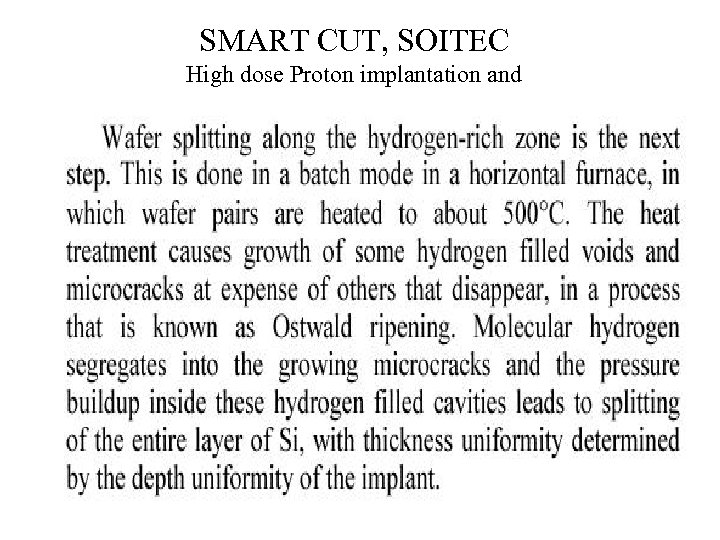
SMART CUT, SOITEC High dose Proton implantation and

ION IMPLANTATION for SEMICONDUCTOR Ion implantation has become the technology preferred by industry to dope semiconductors with impurities in the large scale manufacture of integrated circuits. Ion dose and ion energy are the two most important variables used to define an implant step. Ion dose relates to the concentration of implanted ions for a given semiconductor material. Typically, high current implanters (generally greater than 10 milliamps (m. A) ion beam current) are used for high dose implants, while medium current implanters (generally capable of up to about 1 m. A beam current) are used for lower dose applications.

Ion energy is used to control junction depth in semiconductor devices. The energy levels of the ions which make up the ion beam determine the degree of depth of the implanted ions. High energy processes such as those used to form retrograde wells in semiconductor devices require implants of up to a few (1 -5) million electron volts (Me. V), while shallow junctions may only demand energies below one thousand electron volts (1 Ke. V).
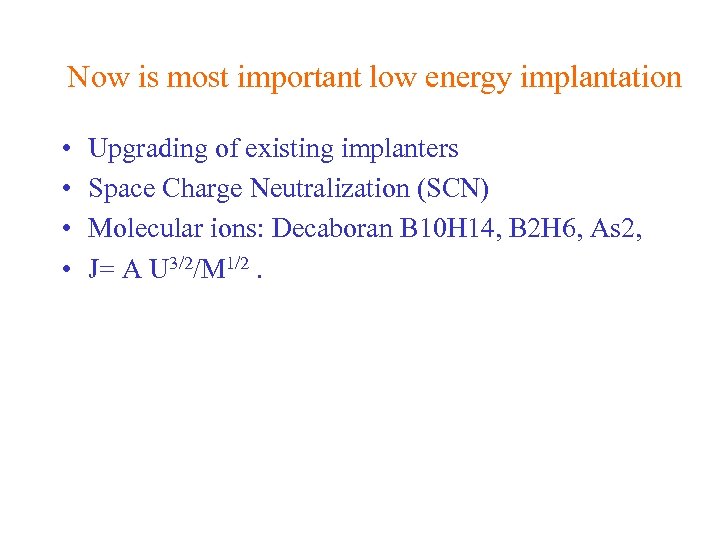
Now is most important low energy implantation • • Upgrading of existing implanters Space Charge Neutralization (SCN) Molecular ions: Decaboran B 10 H 14, B 2 H 6, As 2, J= A U 3/2/M 1/2.
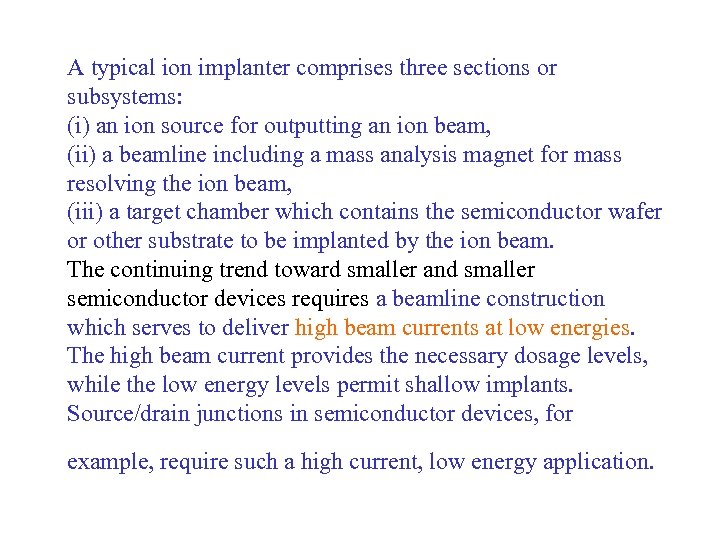
A typical ion implanter comprises three sections or subsystems: (i) an ion source for outputting an ion beam, (ii) a beamline including a mass analysis magnet for mass resolving the ion beam, (iii) a target chamber which contains the semiconductor wafer or other substrate to be implanted by the ion beam. The continuing trend toward smaller and smaller semiconductor devices requires a beamline construction which serves to deliver high beam currents at low energies. The high beam current provides the necessary dosage levels, while the low energy levels permit shallow implants. Source/drain junctions in semiconductor devices, for example, require such a high current, low energy application.

High current low energy implanters

Typical high current implanter for semiconductor

Bernas, Small Anode Ion Source for Implanter • B, P, As, Ge, … • 1, 4 - filaments; 2 -gas discharge chamber; 3 - emission slit; 5 -screen; • 6 -cathode insulator; 7 -small anode; • 8 -anode insulator. • SDS- Gas system: safe delivery system. • Suppliers of parts: Glemco. com • egraph. com
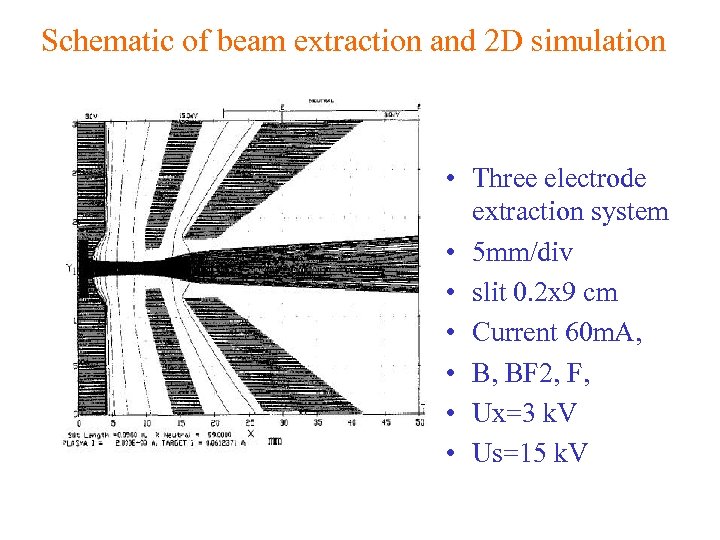
Schematic of beam extraction and 2 D simulation • Three electrode extraction system • 5 mm/div • slit 0. 2 x 9 cm • Current 60 m. A, • B, BF 2, F, • Ux=3 k. V • Us=15 k. V
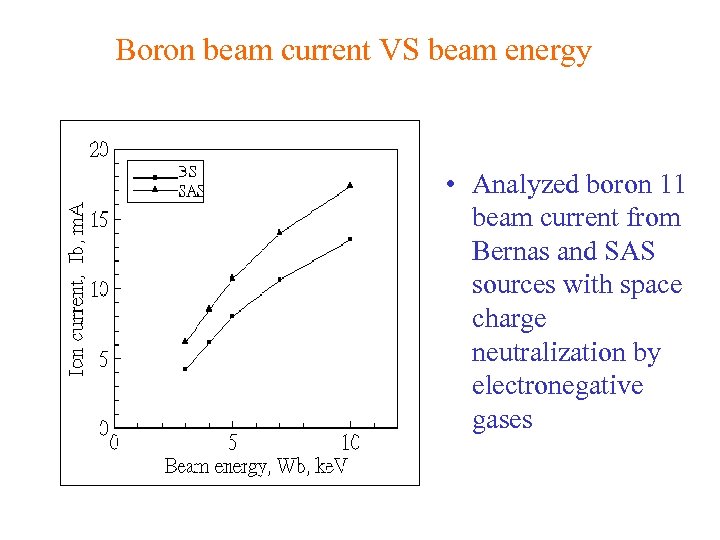
Boron beam current VS beam energy • Analyzed boron 11 beam current from Bernas and SAS sources with space charge neutralization by electronegative gases
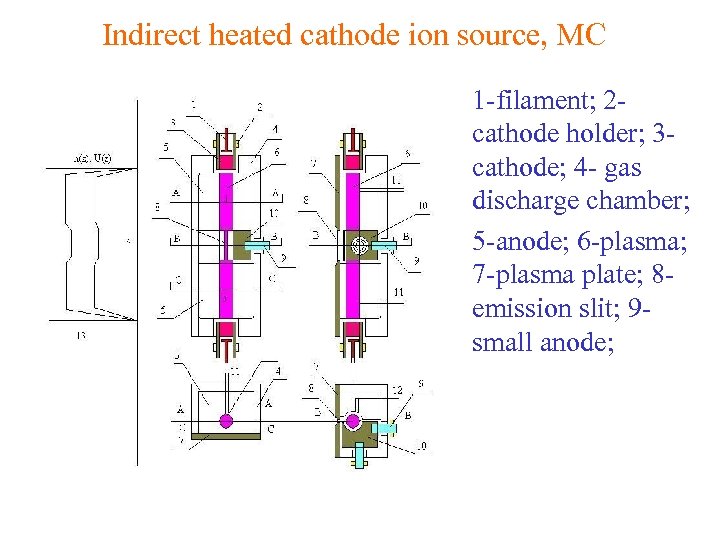
Indirect heated cathode ion source, MC • 1 -filament; 2 cathode holder; 3 cathode; 4 - gas discharge chamber; • 5 -anode; 6 -plasma; 7 -plasma plate; 8 emission slit; 9 small anode;
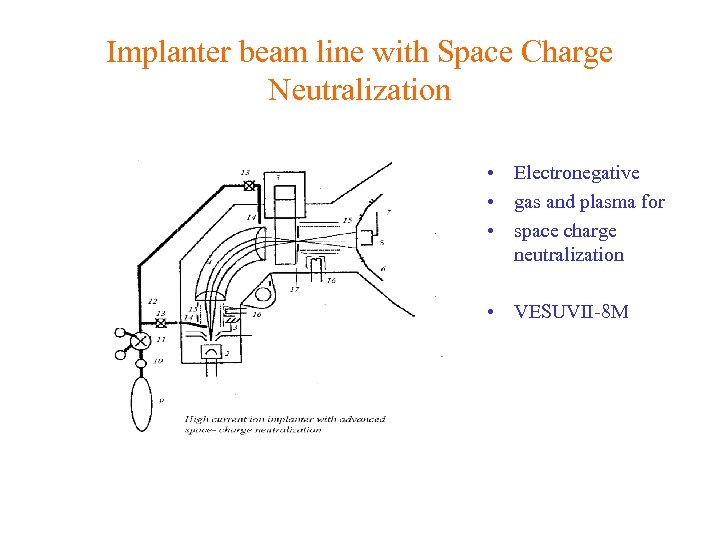
Implanter beam line with Space Charge Neutralization • Electronegative • gas and plasma for • space charge neutralization • VESUVII-8 M
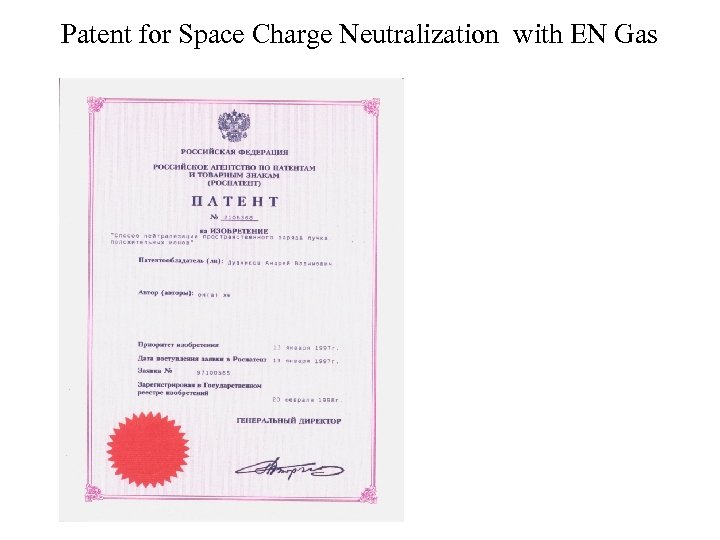
Patent for Space Charge Neutralization with EN Gas

Beam line with advanced space charge neutralization • • 1 -ion source; 2 -ion beam; 3 -gas injector; 4 -magnetic pole; 5 -ion beam; 6 -gas injector; 7 -beam scaner; 8 -beam damp.

High Current Implanter

Low Energy Beam instability • Boron ion beam with energy 5 ke. V
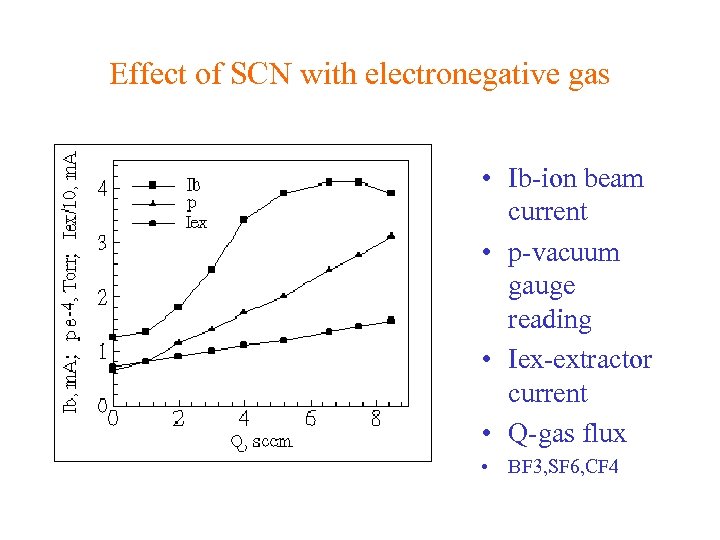
Effect of SCN with electronegative gas • Ib-ion beam current • p-vacuum gauge reading • Iex-extractor current • Q-gas flux • BF 3, SF 6, CF 4
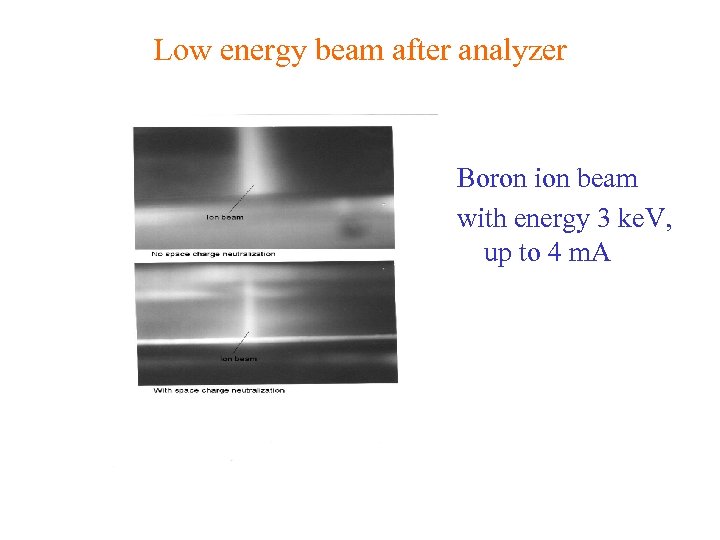
Low energy beam after analyzer Boron ion beam with energy 3 ke. V, up to 4 m. A
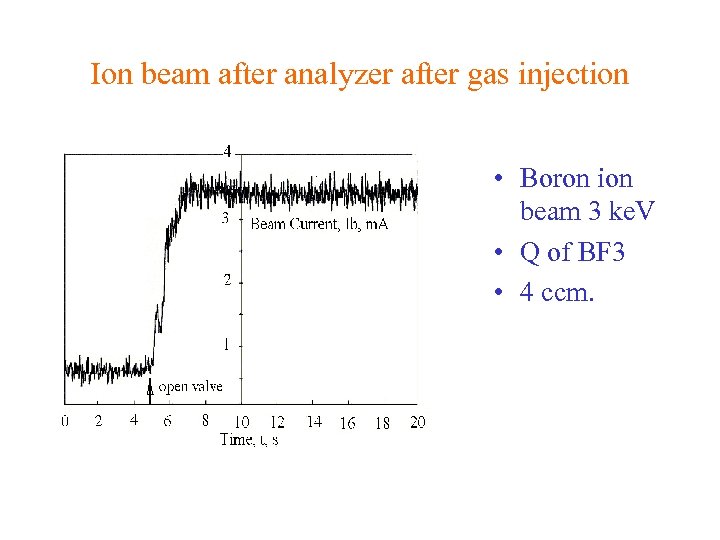
Ion beam after analyzer after gas injection • Boron ion beam 3 ke. V • Q of BF 3 • 4 ccm.
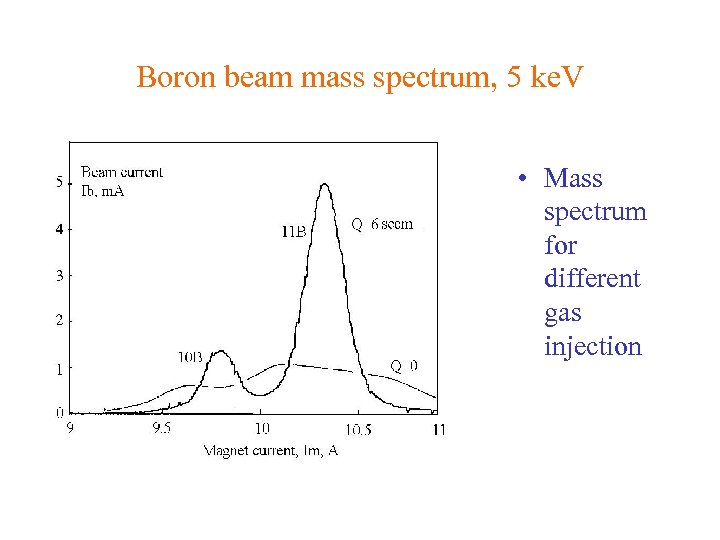
Boron beam mass spectrum, 5 ke. V • Mass spectrum for different gas injection
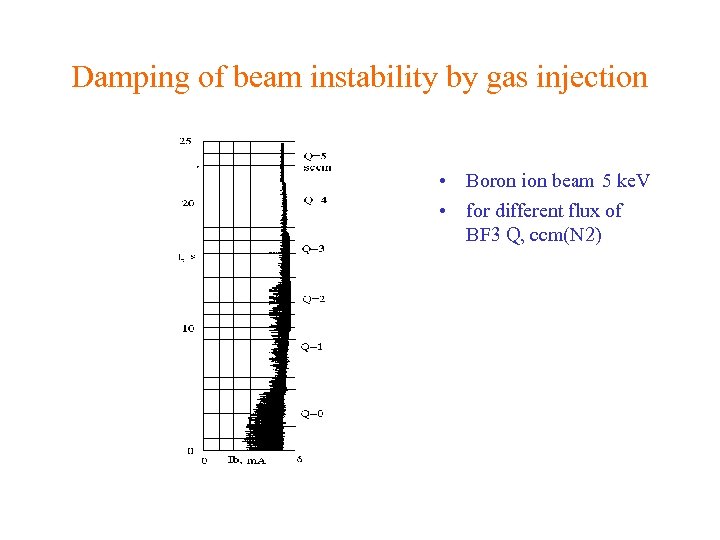
Damping of beam instability by gas injection • Boron ion beam 5 ke. V • for different flux of BF 3 Q, ccm(N 2)

EATON Patent for Space Charge Neutralization
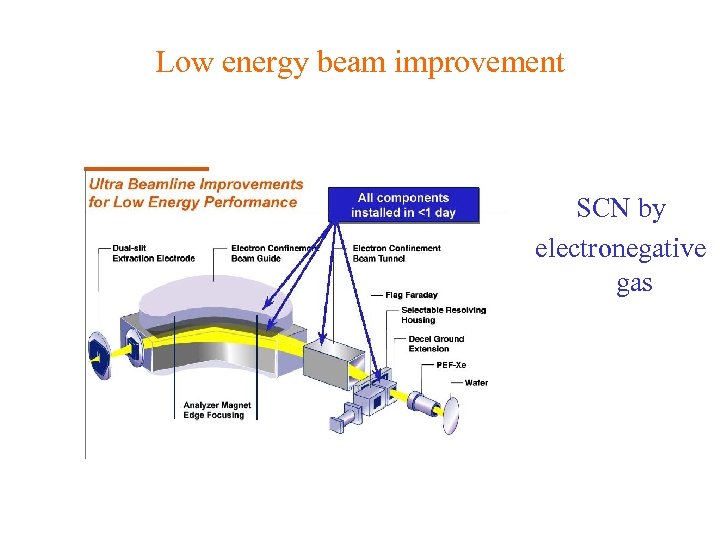
Low energy beam improvement SCN by electronegative gas
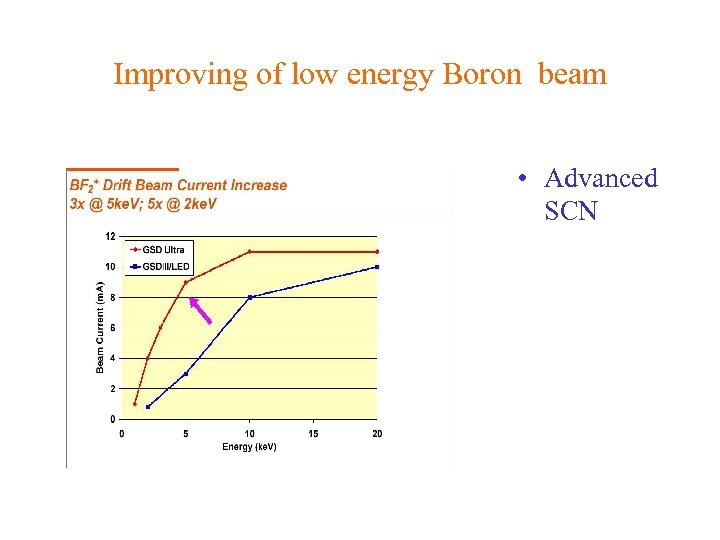
Improving of low energy Boron beam • Advanced SCN

As beam improving by SCN and molecular ions • Molecular ions used for increase a low energy beam intensity: • As 2, • Decaboran • B 10 H 14

ETCHING, DEPOSITION, Micro/Nano Fabrication • • Major Players: Veeco Instruments, Inc Applied Materials Advanced Energy Industrial, …. . Kaufman, RF grid extraction Ion Sources End Hall IS, Anode Layer Plasma Accelerators (ALPA)

Schematic Diagrams of Surface Plasma Sources with Cesium Catalysis of Negative Ion Formation (a) planotron (magnetron) flat cathode (b) planotron geometrical focusing (cylindrical and spherical) (c) Penning discharge SPS (Dudnikov type SPS) (d) semiplanotron (e) hollow cathode discharge SPS with independent emitter (f) large volume SPS with filament discharge and based emitter (g) large volume SPS with anode negative ion production (h) large volume SPS with RF plasma production and emitter 1 - anode 2 - cold cathode emitter 3 - extractor with magnetic system 4 - ion beam 5 - biased emitter 6 - hollow cathode 7 - filaments 8 - multicusp magnetic wall 9 - RF coil 10 - magnetic filter
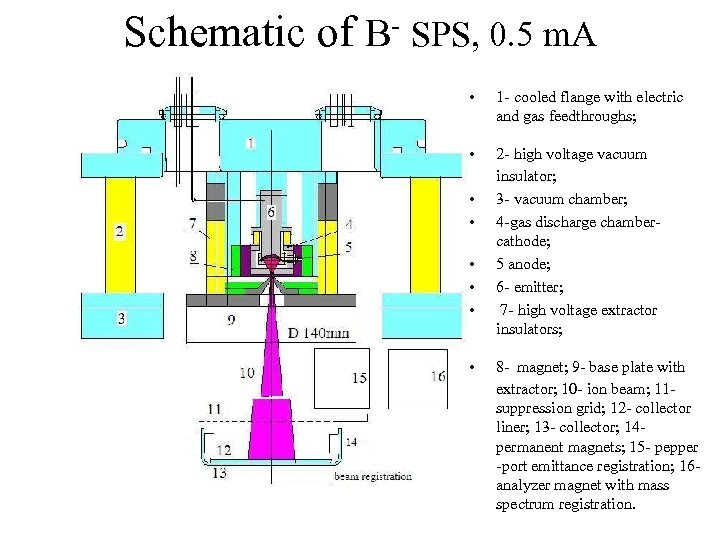
Schematic of B- SPS, 0. 5 m. A • 1 - cooled flange with electric and gas feedthroughs; • 2 - high voltage vacuum insulator; 3 - vacuum chamber; 4 -gas discharge chambercathode; 5 anode; 6 - emitter; 7 - high voltage extractor insulators; • • • 8 - magnet; 9 - base plate with extractor; 10 - ion beam; 11 suppression grid; 12 - collector liner; 13 - collector; 14 permanent magnets; 15 - pepper -port emittance registration; 16 analyzer magnet with mass spectrum registration.
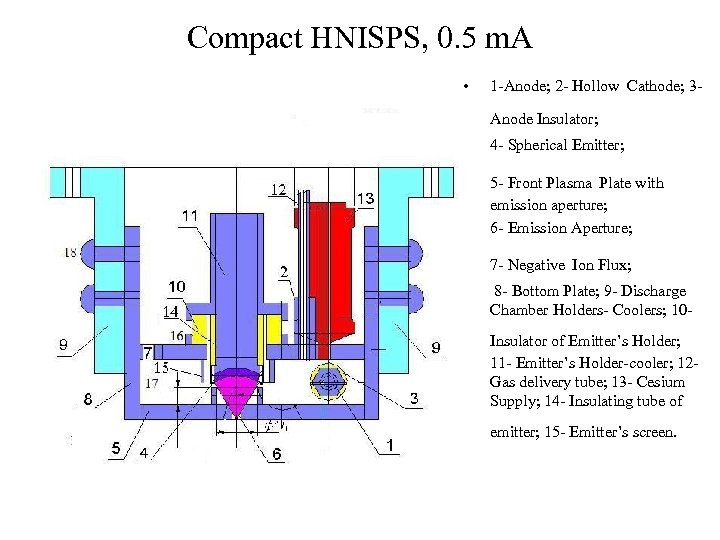
Compact HNISPS, 0. 5 m. A • 1 -Anode; 2 - Hollow Cathode; 3 Anode Insulator; • 4 - Spherical Emitter; • • 5 - Front Plasma Plate with emission aperture; 6 - Emission Aperture; • 7 - Negative Ion Flux; • 8 - Bottom Plate; 9 - Discharge Chamber Holders- Coolers; 10 Insulator of Emitter’s Holder; 11 - Emitter’s Holder-cooler; 12 Gas delivery tube; 13 - Cesium Supply; 14 - Insulating tube of emitter; 15 - Emitter’s screen.
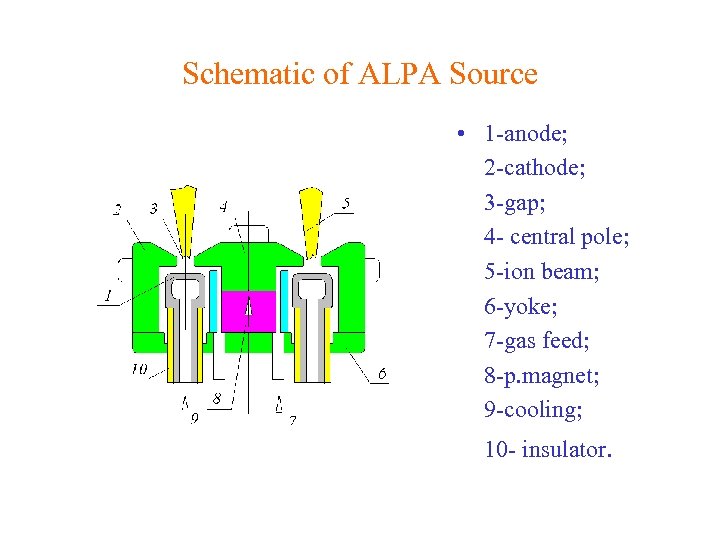
Schematic of ALPA Source • • • 1 -anode; 2 -cathode; 3 -gap; 4 - central pole; 5 -ion beam; 6 -yoke; 7 -gas feed; 8 -p. magnet; 9 -cooling; • 10 - insulator.
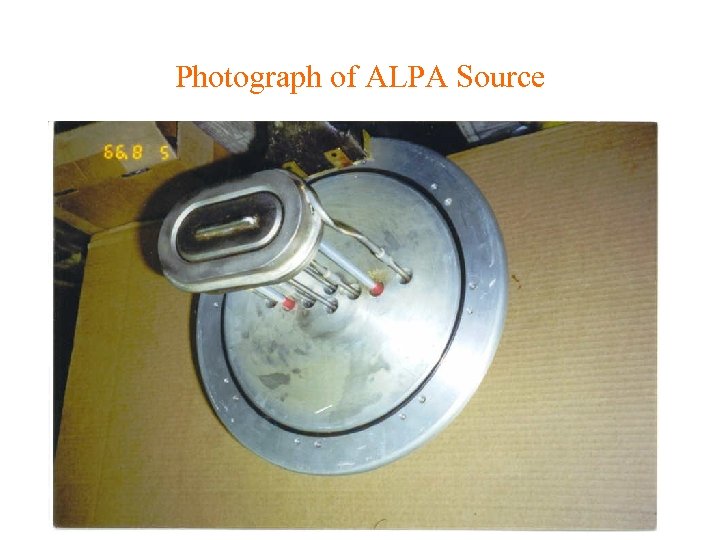
Photograph of ALPA Source
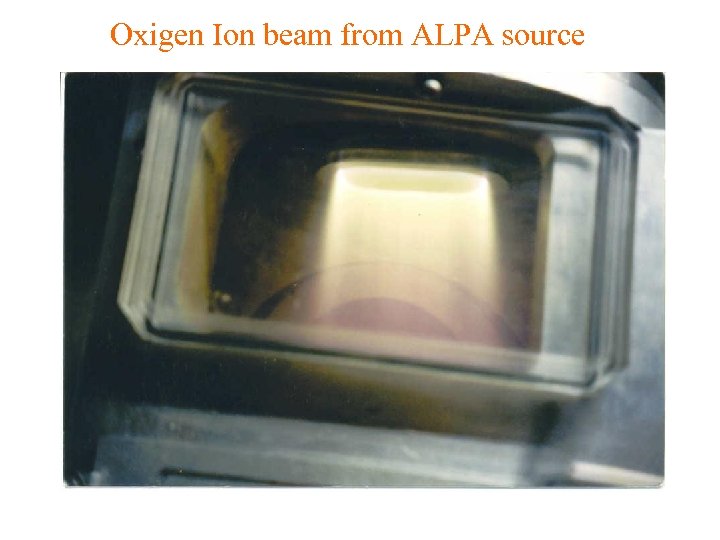
Oxigen Ion beam from ALPA source

BDD, ICIS 2001, ALPA source


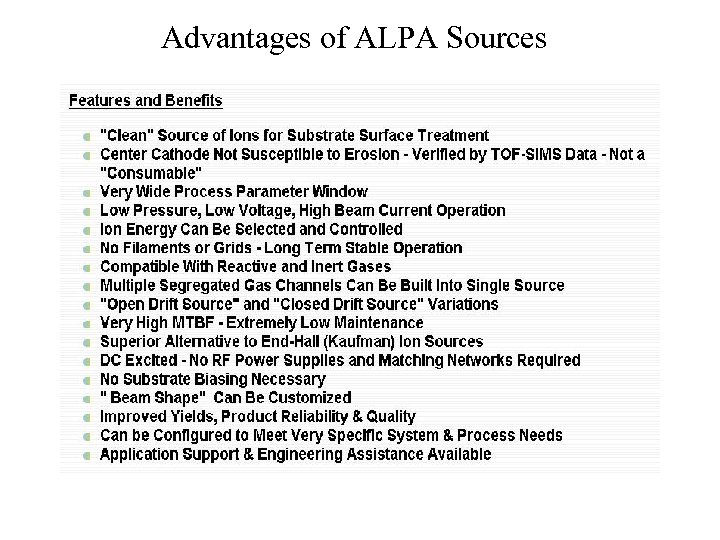
Advantages of ALPA Sources
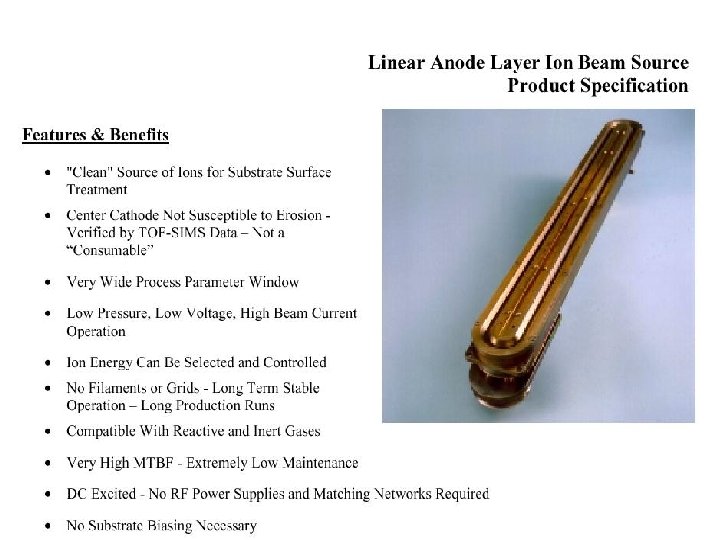


Summary • Modern trend in ion beam technology, as ion implantation for semiconductor, etching, deposition, are considered. • Mass production of Silicon on Insulator (SOI) by Smart Cut Technology use high current proton implanters. Smart Cut Technology now main method of SOI production. • Transition to SOI is limited needs of high energy implantation. • Now is most important high current low energy ion implanters. Methods for increase intensity and stability of low energy beams are discussed. • Development of ion sources for implanters, improving of space charge neutralization, instability damping are components of implanters upgrading. • Anode Layer Plasma Accelerators (ALPA) for broad spectrum of ion beam application now become very popular and many companies start development and manufacturing of ALPA sources.
b0fe2636bc3076811bccc2eb774ce226.ppt